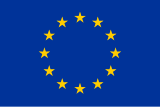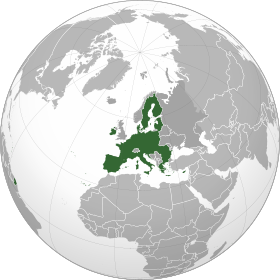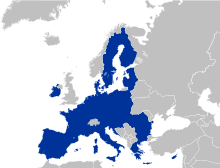Union Europea
| Union Europea | |||||||||||||||||||||||||||||||||||||||||||||||||||
|---|---|---|---|---|---|---|---|---|---|---|---|---|---|---|---|---|---|---|---|---|---|---|---|---|---|---|---|---|---|---|---|---|---|---|---|---|---|---|---|---|---|---|---|---|---|---|---|---|---|---|---|
| |||||||||||||||||||||||||||||||||||||||||||||||||||
 | |||||||||||||||||||||||||||||||||||||||||||||||||||
| Inn Inn de l'Europa | |||||||||||||||||||||||||||||||||||||||||||||||||||

| |||||||||||||||||||||||||||||||||||||||||||||||||||
| Raion de l'Union Europea sul globus | |||||||||||||||||||||||||||||||||||||||||||||||||||

| |||||||||||||||||||||||||||||||||||||||||||||||||||
| L'Union Europea cun si raions speziei | |||||||||||||||||||||||||||||||||||||||||||||||||||
| Sëntes istituzioneles |
| ||||||||||||||||||||||||||||||||||||||||||||||||||
| Majer raion metropolitan | Paris | ||||||||||||||||||||||||||||||||||||||||||||||||||
| Rujenedes ufizieles | 24 rujenedes 3 rujenedes prinzipeles Franzëus • Nglëisc • Tudësch | ||||||||||||||||||||||||||||||||||||||||||||||||||
| Alfabec ufiziei | Latin • Grech • Zirilich | ||||||||||||||||||||||||||||||||||||||||||||||||||
| Religion (2015)[1] |
| ||||||||||||||||||||||||||||||||||||||||||||||||||
| Sort | Union supranaziunela | ||||||||||||||||||||||||||||||||||||||||||||||||||
| Cumëmbri | 27 cumëmbri | ||||||||||||||||||||||||||||||||||||||||||||||||||
| Furmazion • Tratat de Paris • Tratat de Roma • At Sëul Europeich • Tratat de Maastricht • Tratat de Lisboa |
18 auril 1951 1 jené 1958 1 lugio 1987 1 novëmber 1993 1 dezëmber 2009 | ||||||||||||||||||||||||||||||||||||||||||||||||||
Spersa
|
4 236 351 km²[2] 3,08% | ||||||||||||||||||||||||||||||||||||||||||||||||||
Populazion
|
447 706 209 ab.[3] 105,7 ab./km² | ||||||||||||||||||||||||||||||||||||||||||||||||||
PIB (VPC)
|
Stima 2021 | ||||||||||||||||||||||||||||||||||||||||||||||||||
PIB (numinel)
|
Stima 2021 | ||||||||||||||||||||||||||||||||||||||||||||||||||
| Munëida | Euro (€) (EUR) Autres
| ||||||||||||||||||||||||||||||||||||||||||||||||||
| Zona d'orar |
UTC nfin a UTC+2 UTC+1 nfin a UTC+3 | ||||||||||||||||||||||||||||||||||||||||||||||||||
| Plata internet | europa | ||||||||||||||||||||||||||||||||||||||||||||||||||
L'Union Europea ie n'union sëuranaziunela y anterguviernativa de 27 stac mëmbri independënc democratics européesc.
Storia
[mudé | muda l codesc]L'Union européa ie la majera cunfederazion de stac independënc a livel mundiel, crieda sota chëst inuem dl 1992 tres l tratà sun l'Union européa (Tratà de Maastricht). Per n grum d'aspec ejistova l'Union bele dan chësta data tres na sfilza de relazions predezessëures, pian via dal 1951.
Da l ann 2002 ie uni metu it l Euro.

Al mumënt à l'Union européa n marcià chemun unich, fat da n'union duanela, na munëida unica dirijeda da la banca zentrela européa (adurveda per l mumënt da 14 di 27 cumëmbri), na politiga agricula chemuna, na politiga de cumerz chemuna y na politiga chemuna de pëscia. Na politiga furesta y de segurëza chemuna dëssa vester l segond pilier di trëi piliers dl'Union européa. La cunvenzion de Schengen à abolì l cuntrol dl passaport y l cuntrol duanel per n valgun stac dl'Union, crian na lerch de mobilità chemuna per la vita, l lëur, i viages y l'investizions di sentadins dl'UE.
L'istituzions dl'UE plu impuratantes ie l Cunsëi dl'Union européa, la Cumission européa, la Chëurt européa dla Justizia, l Parlamënt europée, l Cunsëi europée y la Banca zentrela européa.
Stac cumëmbri
[mudé | muda l codesc]| Inuem | Unit leprò | Populazion[4] | Spersa (km²) | PIB (milions de US$) |
PIB (VPC) a persona[5] |
Munëida | Gini | ISU |
MEPs | Rujendes |
|---|---|---|---|---|---|---|---|---|---|---|
| 1995 | 8 926 000 | 83 855 | 447 718 | 55,406[6] | euro | 29,1[7] | 0,922[8] | 19 | Tudësch | |
| Fundadëur | 11 566 041 | 30 528 | 517 609 | 50,114[6] | euro | 33,0[7] | 0,931[8] | 21 | Olandesc Franzëus Tudësch | |
| 2007 | 6 916 548 | 110 994 | 66 250 | 23,741[6] | lev | 29,2[7] | 0,816[8] | 17 | Bulgarian | |
| 2013 | 4 036 355 | 56 594 | 60 702 | 27,681[6] | kuna | 29[7] | 0,851[8] | 12 | Croatian | |
| 2004 | 896 000 | 9 251 | 24 280 | 39,079[6] | euro | 31,2[7] | 0,887[8] | 6 | Greek Turkish[lower-alpha 2] | |
| 2004 | 10 574 153 | 78 866 | 246 953 | 40,293[6] | koruna | 25,8[7] | 0,900[8] | 21 | Cech[lower-alpha 3] | |
| 1973 | 5 833 883 | 43 075 | 347 176 | 57,781[6] | krone | 24,7[7] | 0,940[8] | 14 | Danish | |
| 2004 | 1 330 068 | 45 227 | 31 038 | 37,033[6] | euro | 36,0[7] | 0,892[8] | 7 | Estonian | |
| 1995 | 5 527 493 | 338 424 | 269 654 | 49,334[6] | euro | 26,9[7] | 0,938[8] | 14 | Finnish Svedesc | |
| Fundadëur | 67 439 614 | 632 833[9] | 2 707 074 | 45,454[6] | euro | 32,7[7] | 0,901[8] | 79 | Franzëus | |
| Fundadëur[lower-alpha 7] | 83 120 520 | 357 386 | 3 863 344 | 53,571[6] | euro | 31,9[7] | 0,947[8] | 96 | Tudësch | |
| 1981 | 10 682 547 | 131 990 | 214 012 | 29,045[6] | euro | 34,3[7] | 0,888[8] | 21 | Greek | |
| 2004 | 9 730 772 | 93 030 | 170 407 | 32,434[6] | forint | 30,0[7] | 0,854[8] | 21 | Ungaresc | |
| 1973 | 5 006 324 | 70 273 | 384 940 | 89,383[6] | euro | 34,3[7] | 0,955[8] | 13 | Nglëisc Irish | |
| Fundadëur | 59 862 348 | 301 338 | 1 988 636 | 40,065[6] | euro | 36,0[7] | 0,892[8] | 76 | Talian | |
| 2004 | 1 893 223 | 64 589 | 35 045 | 30,579[6] | euro | 35,7[7] | 0,866[8] | 8 | Latvian | |
| 2004 | 2 795 680 | 65 200 | 53 641 | 38,605[6] | euro | 35,8[7] | 0,882[8] | 11 | Lithuanian | |
| Fundadëur | 633 347 | 2 586,4 | 69 453 | 112,875[6] | euro | 30,8[7] | 0,916[8] | 6 | Franzëus Tudësch Luxembourgish[lower-alpha 8] | |
| 2004 | 516 100 | 316 | 14 859 | 43,086[6] | euro | 25,8[7] | 0,895[8] | 6 | Maltesc English | |
| Fundadëur | 17 614 840 | 41 543 | 902 355 | 57,101[6] | euro | 30,9[7] | 0,944[8] | 29 | Olandesc Frisian[lower-alpha 10] | |
| 2004 | 37 840 001 | 312 685 | 565 854 | 33,739[6] | złoty | 34,9[7] | 0,880[8] | 52 | Polach | |
| 1986 | 10 298 252[10] | 92[11] | 236 408 | 33,131[6] | euro | 32,1[12] | 0,864[8] | 21 | Portughesc[lower-alpha 12] | |
| 2007 | 19 186 201 | 238 391 | 243 698 | 30,141[6] | leu | 31,5[7] | 0,828[8] | 33 | Romanian | |
| 2004 | 5 459 781 | 49 035 | 106 552 | 32,184[6] | euro | 25,8[7] | 0,860[8] | 14 | Slovak | |
| 2004 | 2 108 977 | 20 273 | 54 154 | 38,506[6] | euro | 31,2[7] | 0,917[8] | 8 | Slovene | |
| 1986 | 47 394 223 | 504 030 | 1 397 870 | 38,143[6] | euro | 32,0[7] | 0,904[8] | 59 | Spanuel Galician Catalan Occitan Basque[lower-alpha 14] | |
| 1995 | 10 370 000 | 449 964 | 528 929 | 52,477[6] | krona | 25,0[7] | 0,945[8] | 21 | Svedesc | |
| Totals/Averages | – | 447 562 291 | 4 224 488,4 | 15 687 843 | 35,083 | – | (mesaria) 30,8 | (mesaria) 0,897 | 705 | – |
- Notes
- ↑ De facto (though not de jure) excludes the disputed territory of Turkish Cyprus and the U.N. buffer zone. See: Cyprus dispute.
- ↑ The Turkish language is not an official language of the European Union.
- ↑ Officially recognised minority languages:
- ↑ Excludes the autonomous regions of Greenland, which left the then-EEC in 1985, and the Faroe Islands.
- ↑ Includes Åland, an autonomous region of Finland.
- ↑ Includes the overseas regions of French Guiana, Guadeloupe, Martinique, Mayotte, Réunion, Saint Barthélemy, Saint Pierre and Miquelon and the overseas collectivity of Saint Martin. Excludes the overseas collectivities of French Polynesia and Wallis and Futuna; the special collectivity of New Caledonia; Clipperton Island; and the French Southern and Antarctic Lands.
- ↑ On 3 utober 1990, the constituent states of the former German Democratic Republic acceded to the Federal Republic of Germany, automatically becoming part of the EU.
- ↑ The Luxembourgish language is not an official language of the European Union.
- ↑ Excludes the three special municipalities of the Netherlands (Bonaire, Sint Eustatius, and Saba). Also excludes the three other constituent countries of the Kingdom of the Netherlands (Aruba, Curaçao and Sint Maarten).
- ↑ The Frisian language is not an official language of the European Union.
- ↑ Includes the autonomous regions of the Azores and Madeira.
- ↑ Mirandese is an officially recognized minority language. The law provides for its promotion and allows its usage for local matters in Miranda do Douro municipality. It is not an official language of the European Union.
- ↑ Includes the autonomous community of the Canary Islands; the autonomous cities of Ceuta and Melilla; and the territories comprising the plazas de soberanía.
- ↑ Basque, Catalan/Valencian, Occitan and Galician are co-official languages with Castilian Spanish in their respective territories, allowing their use in EU institutions under limited circumstances.[13]
Outermost regions
[mudé | muda l codesc]There are a number of overseas member state territories which are legally part of the EU, but have certain exemptions based on their remoteness; see Overseas Countries and Territories Association. These "outermost regions" have partial application of EU law and in some cases are outside of Schengen or the EU VAT area—however they are legally within the EU.[14] They all use the euro as their currency.
| Territory | Member State | Post | Spersa km2 |
Populazion | PIB a persona (EU=100) |
Zona CVN de l'UE | Zona Schengen |
|---|---|---|---|---|---|---|---|
| Ozean Atlantich | 2,333 | 237,900 | 66.7 | Sci | Sci | ||
| Ozean Atlantich | 7,447 | 1,715,700 | 93.7 | No | Sci | ||
| South America | 84,000 | 161,100 | 50.5 | No | No | ||
| Caribich | 1,710 | 425,700 | 50.5 | No | No | ||
| Ozean Atlantich | 795 | 244,800 | 94.9 | Sci | Sci | ||
| Caribich | 52 | 25,000 | 61.9 | No | No | ||
| Caribich | 1,080 | 383,300 | 75.6 | No | No | ||
| Ozean Indian | 374 | 212,645 | No | No | |||
| Ozean Indian | 2,512 | 837,868 | 61.6 | No | No |
Abbreviations
[mudé | muda l codesc]Abbreviations have been used as a shorthand way of grouping countries by their date of accession.
- EU15 includes the fifteen countries in the European Union from 1 January 1995 to 1 May 2004. The EU15 comprised Austria, Belgium, Denmark, Finland, France, Germany, Greece, Ireland, Italy, Luxembourg, Netherlands, Portugal, Spain, Sweden, and United Kingdom.[16] Eurostat still uses this expression.
- EU19 includes the countries in the EU15 as well as the central European member countries of the OECD: Czech Republic, Hungary, Poland, and Slovak Republic.[17]
- EU11 is used to refer to the Central, Eastern and Baltic European member states that joined in 2004, 2007 and 2013: in 2004 the Czech Republic, Estonia, Hungary, Latvia, Lithuania, Poland, the Slovak Republic, and Slovenia; in 2007 Bulgaria, Romania; and in 2013 Croatia.[18][19]
- EU27 means all the member states. It was originally used in this sense from 2007 until Croatia's accession in 2013, and during the Brexit negotiations from 2017 until the United Kingdom's withdrawal on 31 January 2020 it came to mean all members except the UK.
- EU28 meant all the member states from the accession of Croatia in 2013 to the withdrawal of the United Kingdom in 2020.
Additionally, other abbreviations have been used to refer to countries which have limited access to the EU labour market.[20]
- A8 is eight of the ten countries that joined the EU in 2004, Czech Republic, Estonia, Hungary, Latvia, Lithuania, Poland, the Slovak Republic, and Slovenia.
- A2 is the countries that joined the EU in 2007, Bulgaria and Romania.
Fontanas
[mudé | muda l codesc]- Eric Cò, Unione Europea. Mito o realtà?, Italian University Press, Genova 2010
- Nicoletta Di Sotto, Dalla periferia all'Europa. I partiti etnoregionalisti e l'Unione europea, 2009, Rubbettino Editore, Soveria Mannelli (CZ)
- Timothy Garton Ash, Storia del presente. Dalla caduta del muro alle guerre dei Balcani, Mondadori, Milano 2001
- Bino Olivi, L'Europa difficile. Storia politica dell'integrazione europea, Il Mulino, Bologna 2001
- Sabino Cassese, Democrazia e Unione europea, in “Giornale di Storia costituzionale”, 2002, n. 3, pp. 9–16.
- Sabino Cassese, L’Unione europea come organizzazione pubblica composita, in “Rivista Italiana di Diritto Pubblico Comunitario”, 2000, n. 5, pp. 987–992.
Liams
[mudé | muda l codesc]Referënzes
[mudé | muda l codesc]- ↑ "DISCRIMINATION IN THE EU IN 2015". Special Eurobarometer. 437. European Union: European Commission. 2015. Archivià da l uriginel ai 14 March 2020. Trat ite ai 15 October 2017 – via GESIS.
- ↑ https://www.cia.gov/library/publications/the-world-factbook/geos/ee.html.
- ↑ https://ec.europa.eu/eurostat/tgm/table.do?tab=table&init=1&plugin=1&language=en&pcode=tps00001.
- ↑ "Council Decision (EU, Euratom) 2021/2320 of 22 December 2021 amending the Council's Rules of Procedure". Decision[[:Template:Space]]No. 2021/2320[[:Template:Space]]of[[:Template:Space]]Error: the
dateoryearparameters are either empty or in an invalid format, please use a valid year foryear, and use DMY, MDY, MY, or Y date formats fordate. Council of the European Union.{{cite book}}: URL–wikilink conflict (help) - ↑ at purchasing power parity, per capita, in international dollars (rounded)
- ↑ 6,00 6,01 6,02 6,03 6,04 6,05 6,06 6,07 6,08 6,09 6,10 6,11 6,12 6,13 6,14 6,15 6,16 6,17 6,18 6,19 6,20 6,21 6,22 6,23 6,24 6,25 6,26 "IMF". www.imf.org (per inglese americano). Trat ite ai 5 December 2020.
- ↑ 7,00 7,01 7,02 7,03 7,04 7,05 7,06 7,07 7,08 7,09 7,10 7,11 7,12 7,13 7,14 7,15 7,16 7,17 7,18 7,19 7,20 7,21 7,22 7,23 7,24 7,25 "worldbank.org".
- ↑ 8,00 8,01 8,02 8,03 8,04 8,05 8,06 8,07 8,08 8,09 8,10 8,11 8,12 8,13 8,14 8,15 8,16 8,17 8,18 8,19 8,20 8,21 8,22 8,23 8,24 8,25 8,26 "Human Development Report 2020" (PDF). United Nations. Trat ite ai 12 August 2021.
- ↑ Anonymous (5 July 2016). "Living in the EU - European Union - European Commission". European Union. Archivià dal uriginel ai 27 April 2017. Trat ite ai 26 April 2017.
- ↑ "Statistics Portugal - Web Portal". www.ine.pt. Archivià dal uriginel ai 18 November 2018. Trat ite ai 10 June 2019.
- ↑ "Portugal tem 92.212 quilómetros quadrados, por enquanto... - Sociedade - PUBLICO.PT". 5 October 2012. Archivià da l uriginel ai 5 October 2012.
- ↑ "Índice de Gini (percentagem)". www.pordata.pt. Archivià dal uriginel ai 16 February 2020. Trat ite ai 1 February 2020.
- ↑ "Regional and minority languages in the European Union" (PDF) (PDF). European Parliament Members' Research Service. September 2016. Archivià (PDF) dal uriginel ai 17 May 2018. Trat ite ai 16 January 2019.
- ↑ Regional policy & outermost regions Archived 16 setëmber 2011 te la Wayback Machine, European Commission
- ↑ "Council Directive 2013/61/EU of December 2013" (PDF). 17 December 2013. Archivià dal uriginel ai 2 January 2014. Trat ite ai 1 January 2014.
- ↑ "OECD Glossary of Statistical Terms - EU15 Definition". stats.oecd.org. Archivià dal uriginel ai 26 October 2019. Trat ite ai 13 August 2019.
- ↑ "OECD Glossary of Statistical Terms - EU21 Definition". stats.oecd.org. Archivià dal uriginel ai 31 October 2013. Trat ite ai 13 August 2019.
- ↑ Vértesy, László (2018). "Macroeconomic Legal Trends in the EU11 Countries" (PDF). Public Governance, Administration and Finances Law Review. 3. No. 1. 2018. Archivià da l uriginel (PDF) ai 12 August 2019. Trat ite ai 13 August 2019.
- ↑ Loichinger, Elke; Madzarevic-Sujster, Sanja; Vincelette, Gallina A.; Laco, Matija; Korczyc, Ewa (1 June 2013). "EU11 regular economic report" (per inglese): 1–92. Archivià dal uriginel ai 12 August 2019. Trat ite ai 13 August 2019.
{{cite journal}}: Cite journal requires|journal=(help) - ↑ "Who are the "A8 countries"?" (per inglese britannico). 24 April 2005. Archivià dal uriginel ai 10 May 2020. Trat ite ai 1 March 2020.
- CS1 errors: URL–wikilink conflict
- CS1 inglese americano-language sources (en)
- CS1: long volume value
- CS1 errors: missing periodical
- CS1 inglese britannico-language sources (en)
- Articles containing bulgar-language text
- Articles containing cech-language text
- Articles containing croat-language text
- Articles containing danesc-language text
- Articles containing eston-language text
- Articles containing finlandesc-language text
- Articles containing franzëus-language text
- Articles containing irlandesc-language text
- Articles containing Greek-language text
- Articles containing leton-language text
- Articles containing Lithuanian-language text
- Articles containing Maltese-language text
- Articles containing nglëisc-language text
- Articles containing oalndesc-language text
- Articles containing Polish-language text
- Articles containing Portuguese-language text
- Articles containing rumen-language text
- Articles containing slovach-language text
- Articles containing sloven-language text
- Articles containing spanuel-language text
- Articles containing svedesc-language text
- Articles containing talian-language text
- Articles containing tudësch-language text
- Articles containing ungaresc-language text
- Articles with hatnote templates targeting a nonexistent page
- Union européa
